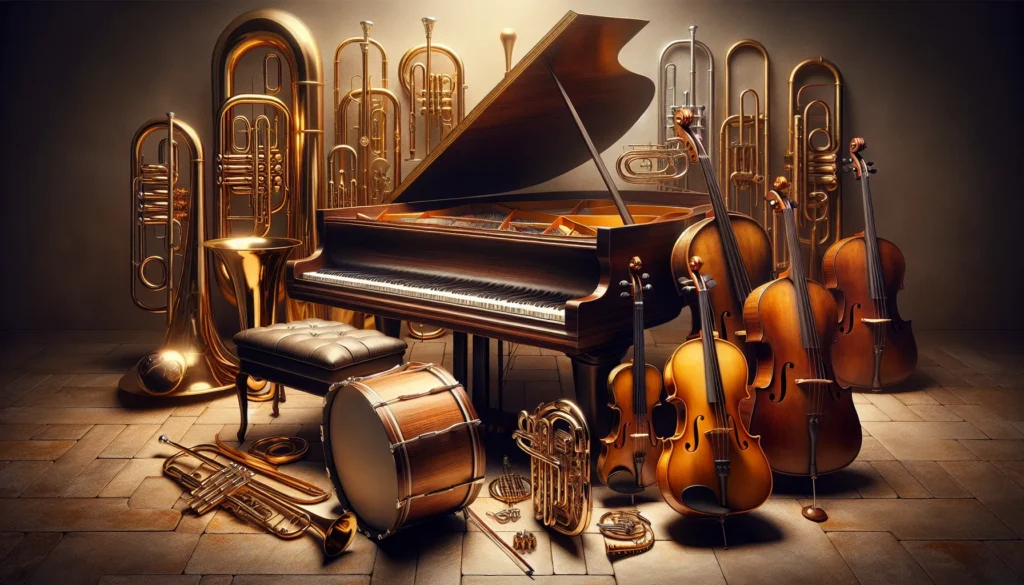Table of Contents
ToggleMusic has always been a reflection of its time, but comparing the classical era to the vibrant sounds of the twentieth century is like pitting Mozart against a rock band—both brilliant, yet worlds apart. While classical composers crafted intricate symphonies that could make even the most stoic listener weep, the twentieth century unleashed an explosion of genres that turned the music scene upside down. From jazz to rock and everything in between, the evolution of sound became a playground for experimentation and innovation.
Overview of Classical Era Music
Classical era music, spanning roughly from 1750 to 1820, showcases formal structures and emotional depth. Its influence on contemporary music remains significant.
Key Characteristics of Classical Music
Clarity and balance define classical music, where composers prioritize form and structure. Compositions often feature distinct themes and motifs. Harmony plays a crucial role, enhancing emotional expression while maintaining a stable framework. Dynamics and articulation create contrast, adding richness to the listening experience. The use of orchestral ensembles allows for a range of timbres and textures.
Major Composers of the Classical Era
Mozart stands out among the prominent composers, known for his symphonies, operas, and chamber music. Haydn’s contributions to the development of the symphony and string quartet are foundational. Beethoven, bridging classical and romantic styles, introduced emotional intensity and innovation in his works. These composers significantly shaped the music of their time, leaving an enduring legacy that continues to resonate today.
Overview of Twentieth-Century Music
Twentieth-century music marks a transformative era characterized by experimentation and innovation. This period reflects a departure from the formal structures of the classical era, embracing diverse genres that shape the musical landscape.
Key Characteristics of Twentieth-Century Music
Diversity defines the music of the twentieth century. Genres like jazz, rock, and electronic music emerged, fostering a spirit of experimentation. Unlike classical music, which often emphasized harmony and clear structures, twentieth-century compositions prioritize rhythm and texture. Avant-garde techniques, including atonality and polytonality, challenged traditional norms. The blending of various musical influences, from folk to electronic, further showcases this era’s creative diversity.
Influential Composers of the Twentieth Century
Many composers left a lasting mark on twentieth-century music. Igor Stravinsky’s innovative use of rhythm and orchestration redefined musical boundaries with works like “The Rite of Spring.” Leonard Bernstein combined classical traditions with American musical styles, making a significant impact. Similarly, John Cage introduced concepts of chance music, expanding the definition of composition. These figures, among others, played crucial roles in shaping the sonic identity of the twentieth century.
Comparative Analysis
The differences between twentieth-century music and classical era music emphasize distinct approaches to composition and expression.
Melodic Structures
Classical era music often features clear, defined melodies that reflect formal themes. Composers like Mozart and Beethoven prioritized straightforward melodic lines, allowing emotions to resonate clearly. In contrast, twentieth-century music embraces complexity and fragmentation. Composers utilize dissonance and unconventional scales, making melodies less predictable. The infusion of jazz and folk elements led to innovative melodic structures. Many works integrate improvisation, blending different styles to create unique, fluid musical phrases.
Rhythmic Innovations
Rhythm in classical music adheres to established measures and time signatures. Composers such as Haydn employed structured patterns to maintain coherence. Twentieth-century music, however, showcases a departure from this rigidity. Rhythm becomes more varied and complex, reflecting influences from jazz and world music. Some composers experiment with polyrhythms, layering multiple, contrasting rhythmic patterns. This shift encourages improvisation and spontaneity, altering the listener’s perception of rhythm. The evolution of rhythm marks a significant distinguishing feature between the two eras.
Use of Harmony and Chord Progressions
Harmony in the classical era relies on functional progression and resolution. Composers utilized a clear tonal center to create emotional depth. The richness of chords contributes to the structural integrity of pieces. In contrast, the twentieth century explores more dissonant harmonies and unconventional progressions. Atonality and polytonality emerge as key characteristics, challenging traditional harmonic norms. Composers experiment with extended chords, enriching the sound palette. This exploration enables a broader emotional spectrum and expands the listener’s auditory experience.
Cultural Contexts
Cultural influences profoundly shaped both classical and twentieth-century music. Understanding these contexts reveals how societal dynamics impacted musical development.
Societal Influences on Classical Music
The classical era reflected the values and norms of its time, particularly during the Enlightenment. An emphasis on reason and individualism fueled musical innovation. Composers like Mozart captured the essence of their society through structured forms and emotional expression. The patronage system created a framework where artists thrived under the support of the aristocracy. Concerts became social events, engaging the public and enhancing the appreciation of music. Additionally, the development of public concerts made music accessible beyond elite circles, broadening its impact.
Societal Influences on Twentieth-Century Music
The twentieth century marked dramatic societal shifts, which greatly influenced musical trends. Events like the world wars and the civil rights movement played crucial roles in shaping musical expressions. Genres such as jazz emerged from African American communities, reflecting cultural resilience and innovation. Experimentation took center stage as musicians responded to rapid changes in technology and culture. The rise of popular media allowed music to reach diverse audiences, allowing artists to explore new styles. Social commentary found its way into songs, with artists using music as a vehicle for political expression.
The comparison between twentieth-century music and classical music reveals a fascinating evolution in artistic expression. While classical music emphasizes structured forms and emotional depth, the twentieth century breaks free from tradition, embracing experimentation and diverse genres. This shift reflects broader cultural changes and technological advancements that shaped the musical landscape.
As a result, listeners experience a richer emotional spectrum through the innovative techniques of the twentieth century. The legacy of classical composers continues to influence modern music, but the bold creativity of the twentieth century has redefined what music can be. Understanding these differences not only enhances appreciation for both eras but also highlights the ongoing dialogue between tradition and innovation in music.





